
Writing and creative work is hard.
Sometimes you sit there, pumped up and ready to get to it… and nothing happens.
Pen does not meet paper. Words do not appear.
And after what seems like a small eternity, when you finally start to write… it’s gibberish. Garbage. Unusable.
But it doesn’t have to be that way.
What if there was a way — a system — where you could consistently produce quality output, day, after day, after day?
Well, there is.
And I’m going to give it to you right now.
This is the exact system that I’ve used over the past year to publish two long-form articles every week, without fail.
On my best days I write 5,000 words. On my worst days, at least 1,000 words.
And the great thing about this is that it’s a system. This means that anyone can do it, and that you can always fall back on the principles of the system to help get your writing done.
No matter if you write for yourself, on Medium or anywhere else, you can use the same system to consistently produce quality output.
Most articles about writing discuss how to improve expression or how to get more views for your articles. Some even discuss inspiration and creativity. But very few cover an actual process for how writers can consistently produce good work over time.
So here it is — how to write 5,000 words a day.
The Inner Game of Writing

Your inner game or mindset is the most important thing when it comes to consistently writing.
Here are some beliefs that I believe are useful for consistently producing good work in quantity.
Belief 1: Writing is a system and anyone can do it
Writing is a system.
Yes, we all have different levels of natural talent and acquired skill.
But at the end of the day, with a basic level of writing talent or skill, anyone can operate a system that still results in consistently good output.
Some people may object to the idea that a creative endeavour like writing can be systemised and turned into a routine.
This is silly.
By having a system or framework within which we can consistently produce creative expression, we are far more likely to actually produce work than without it.
This is the approach that Steven Pressfield of The War of Art takes — you have a system for showing up and practicing the war of art.
“Going to war” with your creativity means that you use routine and discipline, show up on time, put pen to paper and trust in your system for writing to get it done.
As is commonly said, routine sets you free.
Belief 2: Inspiration is perishable
I learnt this from Jason Fried and DHH of Basecamp.
They say that inspiration is perishable, so use it when you can.
I believe this is true — if you have a great idea in mind, you should use the momentum of that idea and ride the chaos and get your writing done during that time.
Whenever you feel creativity arise, just go for it.
And when you lack inspiration, you can fall back on belief #1, which is that writing is a system.
Belief 3: Quantity vs quality
Writing is a skill just like anything else. The more you practice it, the better you get at it.
In the beginning, it is likely that quantity will be more important than quality for you.
You just need to write many, many things and get in the practice. As James Clear puts it, when he started writing he would aim for producing two articles a week, so about eight a month. Of these eight, he expected two to be great, two to be bad, and four to be average.
Not everything you write has to be Pulitzer or Booker-worthy.
As your writing improves though, quality becomes more important than quantity.
This is when you understand the form of your writing, and your routine, systems and habits around writing are established and strong, and you can take the time to step back and hone your craft and words.
The truth that many writers don’t want to hear is that it is hard to produce quality material at the pace of more than two long-form articles per week.
If you want an example of this, check out writers who publish 5-10 articles a day on Medium. Occasionally they’ll produce an amazing piece, but most of it is frankly, poorly written and the ideas have not been well thought-through.
Some of these writers are in their “quantity” phase and that is respectable and admirable. But at some point, we all have to slow it down to produce higher quality work.
Belief 4: The best writing is not the most read
The uncomfortable truth of all arts (and business) is that the best works (and products) are not the most appreciated or used.
Just because you’ve created something amazing… it doesn’t mean that everyone else will recognise its value right away.
This is doubly true in today’s day and age given the amount of information and stimuli that people are bombarded with daily.
What this means is that while you may think your writing has amazing value (and it may very well have), you still need to sell it.
As an artist this flat-out SUCKS because you believe that the work you produce should be able to stand on its own.
But that just isn’t the way that the world works.
Don’t take it from me — both Peter Thiel in Zero to One and Ryan Holiday in Perennial Seller clearly and unequivocally state: Just because you build it, doesn’t mean they will come.
You not only need to produce great work… you also need to market it for it to be read.
Belief 5: You can’t please everyone
No matter how amazing, neutral or wholesome your work is, you will have haters.
Some people out there are just broken in some way or another and want to make their opinions known, usually in a nasty way.
Everyone who produces creative work, from the journeyman writer to best-selling authors, will come across haters during their writing career.
The best way to handle them is to just accept that you can’t please everyone and to move on. Some people will love what you have to offer and some won’t, and that’s OK. There are no awards for arguing with haters, especially on the Internet.
Belief 6: Writing is a small part of an overall process
Most people think that writing is this amazing moment of inspiration where you sit down in front of a typewriter and thoughts suddenly flow from your mind to your hands to the keys and hundreds of pages of manuscript appear.
The truth is the actual sit-down-and-write part is maybe 20% of the process. The rest of the “writing system” consists of planning, editing, polishing, proofreading and more.1Hat tip Dr Clare Lynch of Dorris and Bertie.
Tools for Writing
Some people are of the impression that a specific type of notebook, pen or writing app will make them an amazing writer.
This could not be further from the truth.
Nice notebooks, ergonomic pens and well-designed writing applications will make your writing experience more pleasant, but that’s about it.
My general advice is to pick whatever tools you like and are comfortable with and use them, as that will motivate you to write more.
Let’s look into some specifics.
Tools for planning
We’ll talk about the different stages of the writing process in the next section, but these are the tools I like for planning.
1. Mind maps
Mind maps look like this:
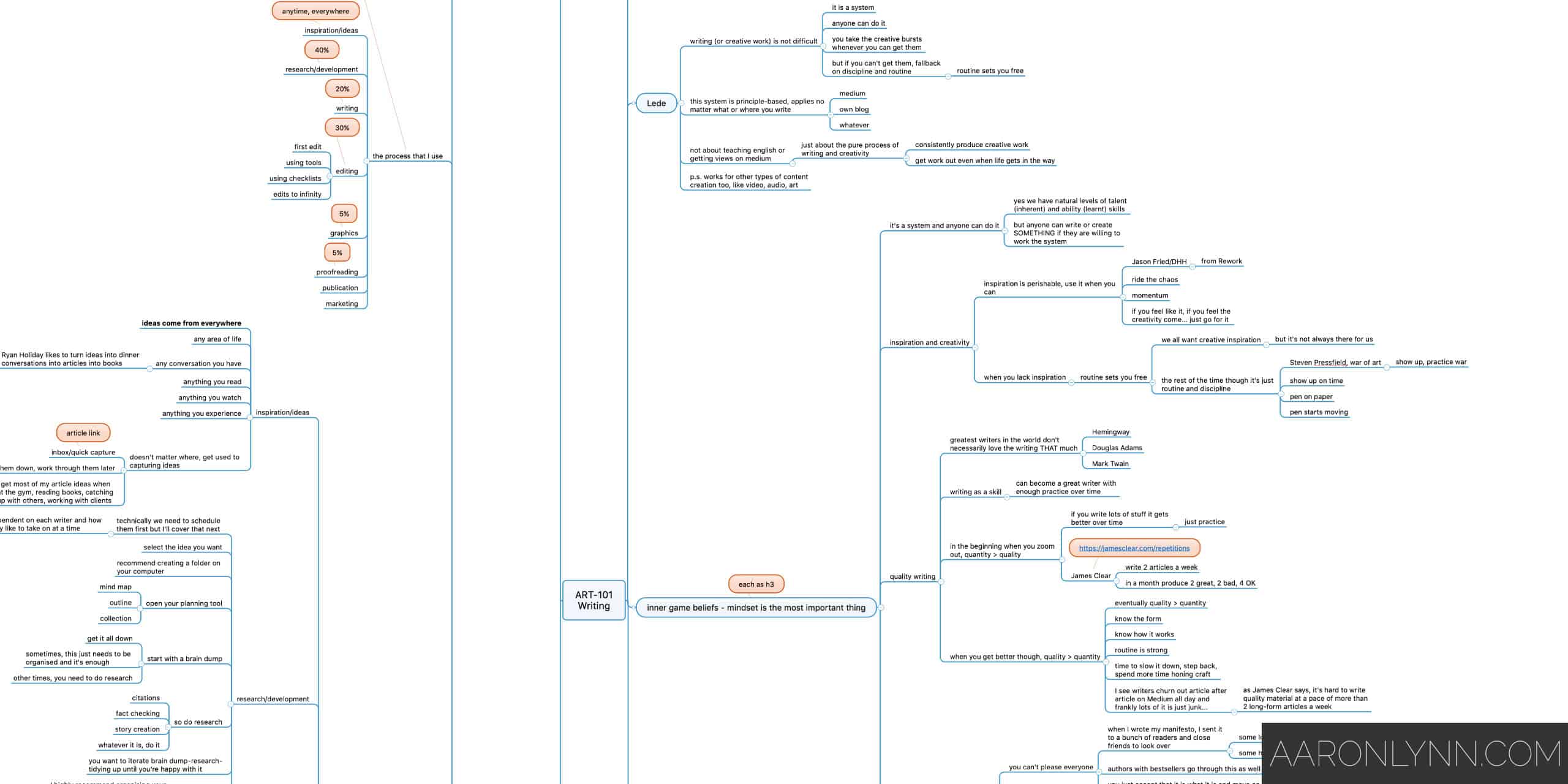
They are my preferred tool for research and planning articles as I can quickly rearrange ideas, writing flow and add/remove concepts as I need to.
I like Mindjet MindManager, others like Mindnode. There are many, many other alternatives available as well.
2. Outlines
Some people prefer outlines to mind maps and that’s perfectly fine.
They are literally a linear text document with some bullet points about the different concepts explored in a piece of writing.
This can be done in any word-processing application like Microsoft Word or Google Docs.
3. Collections
A collection is a compilation of papers, notes, post-its or ideas that you put together during your planning phase.
These add up to the overall theme of the piece you are writing.
For shorter-form pieces like articles or guides you probably don’t need a collection, but for something longer like a book or article series you will.
Some applications like Scrivener have a collection feature built-in, but a folder on your computer or a paper folder works just as well.
Writing apps and tools
There are many different apps and tools available for writers nowadays — and that’s a good thing.
I personally like and use Ulysses (which I’m writing in right now) as it has a typewriter mode, markdown support and publication features for WordPress.
I’ve also heard good things about Scrivener but haven’t used it for a number of years.
Pen and paper or a typewriter also work if you want to go old-school.
And of course, there’s nothing wrong with writing in Microsoft Word or Google Docs.
Editing tools
Editing tools are a more recent invention, and they essentially use algorithms to help you improve your grammatical and linguistic expression.
Grammarly is the most heavily promoted editing tool online. I personally don’t use it as I think my grammar is pretty good, but I’ve seen it to be incredibly useful for non-native English speakers.
Hemingway is a tool that helps you clean up expressions, complicated sentences and adverb usage, supposedly as Hemingway would have done. I do run all my writing through the app — and then proceed to ignore most of the suggestions 🙂.
Ulysses now has a built-in style editor powered by LanguageTool Plus. I haven’t used it extensively but it seems complementary to Hemingway and I’ll be running my writing through it as well.
Standard operating procedures for writing
The last set of “tools” I consider useful for writing are standard operating procedures (SOPs).
SOPs are written documents that outline how to complete a certain process, in this case the stages of the writing process.
In practical terms this means that I have SOPs for research, writing, editing and all the other stages of my writing system.

These SOPs have checklists so that I don’t miss anything at each stage, and so that I know what to do next to push each piece of writing forward.
They also make writing easier on the days when I have little inspiration — as mentioned before, routine sets you free.
The Writing Process
Here is the full writing process and system that I use to produce consistent output every single day.
Remember:
- Writing, editing and planning are not the same.
- Routine is important, but just sitting down and putting pen to paper does not produce greatness. Unless you’re Seth Godin.
- Writing is only about 20% of the process.
This system is geared towards producing blog and online content but can be easily modified for writing other genres and forms — simply remove the “graphics” and “publication” stages and replace them with “typesetting” or what you require.
Writing process overview
| # | Stage |
| 1 | Inspiration and ideas (anytime, anywhere). |
| 2 | Research and development (40%). |
| 3 | Writing (20%). |
| 4 | Editing (30%). Broken up into first edit, tool editing, checklist editing, edits to infinity. |
| 5 | Graphics (5%). |
| 6 | Proofreading (5%). |
| 7 | Publication/Typesetting. |
| 8 | Marketing. |
1. Inspiration and ideas
Your inspiration and ideas come from everywhere.
Any conversation you have had. Anything you have read. Anything you have watched. Anything you have experienced.
As a writer, everything you eat, live, breathe and do can be sourced to create ideas for something to write.
It doesn’t matter where you get your ideas and inspiration from, but you must have a process for capturing and then developing them.
I recommend a quick capture/inbox system for quickly jotting down ideas when they arise.
Get them down first, and then work through them later.
I get most of my article ideas when at the gym, reading books, having lunches/dinners/coffees with others and working with clients.
2. Research and development
Once you have your list of ideas, you need to select one and start developing it.
Selection is dependent on what you are writing for (blog, Medium, magazine, book, otherwise) and I’ll cover my process for that in the How I Write section.
But for now, you can take a selected idea and start developing it.
This can be as simple as creating a folder on your computer to collect material related to the idea, and starting your choice of a mind map or outline.
I recommend starting with a brain dump.
This is where you sit down and get down all your thoughts related to the idea. It doesn’t need to be organised, edited or refined at this point, just get it all down.
Once you have done this, one of two things will be clear. Either:
- Everything’s already there and you just need to organise it a bit. Or,
- You need to do more research.
If you need to do more research, then do it. Look up your citations, research papers, perform fact checks and craft stories.
Note: Some pieces of writing require a lot of research, some will require none.
Once this research is done, go back to the brain dump step.
And continue alternating between brain dumping and researching until you’re happy with the initial outline/plan.
When you feel (yes, feel) that there is nothing more to research or get down on paper, then organise your outline or mind map so that’s it coherent and flows linearly.
Why?
Because it is always easier to write something if you know what the end is before you start.
Remember, research and development is 40% of our writing process and you should be spending the most time on it. If you get it right, then the rest is easy!
You will know that you are “done” with research and development when you can read through your plan, and see or hear the entire article unfold in your mind… before you’ve even written a word.
3. Writing
Finally — the actual writing process!
I strongly suggest leaving at least a day between when you complete your research and when you sit down to write. This is to let your brain consolidate your ideas and thoughts while you sleep, which makes for better writing.
You will want to use a deep work setup for writing. This means:
- Your favourite beverage on hand (tea, coffee, water).
- Some good music, with noise-cancelling headphones if you need them. I personally prefer instrumental/soundtrack music for writing.
- Adequate time set aside. This really depends on the length of your piece and its difficulty level. A good estimate is one hour per every 2,000 words you want to write.
- No interruptions. Close the door if you have to.
- Put your phone in another room or a desk drawer, out of sight.
- If you have a smartwatch, silence the notifications.
- If you have a writing app with a focus or typewriter mode, turn it on.
Once you’ve set up your deep work conditions, it’s time to sit down and write.
I personally use this setup:
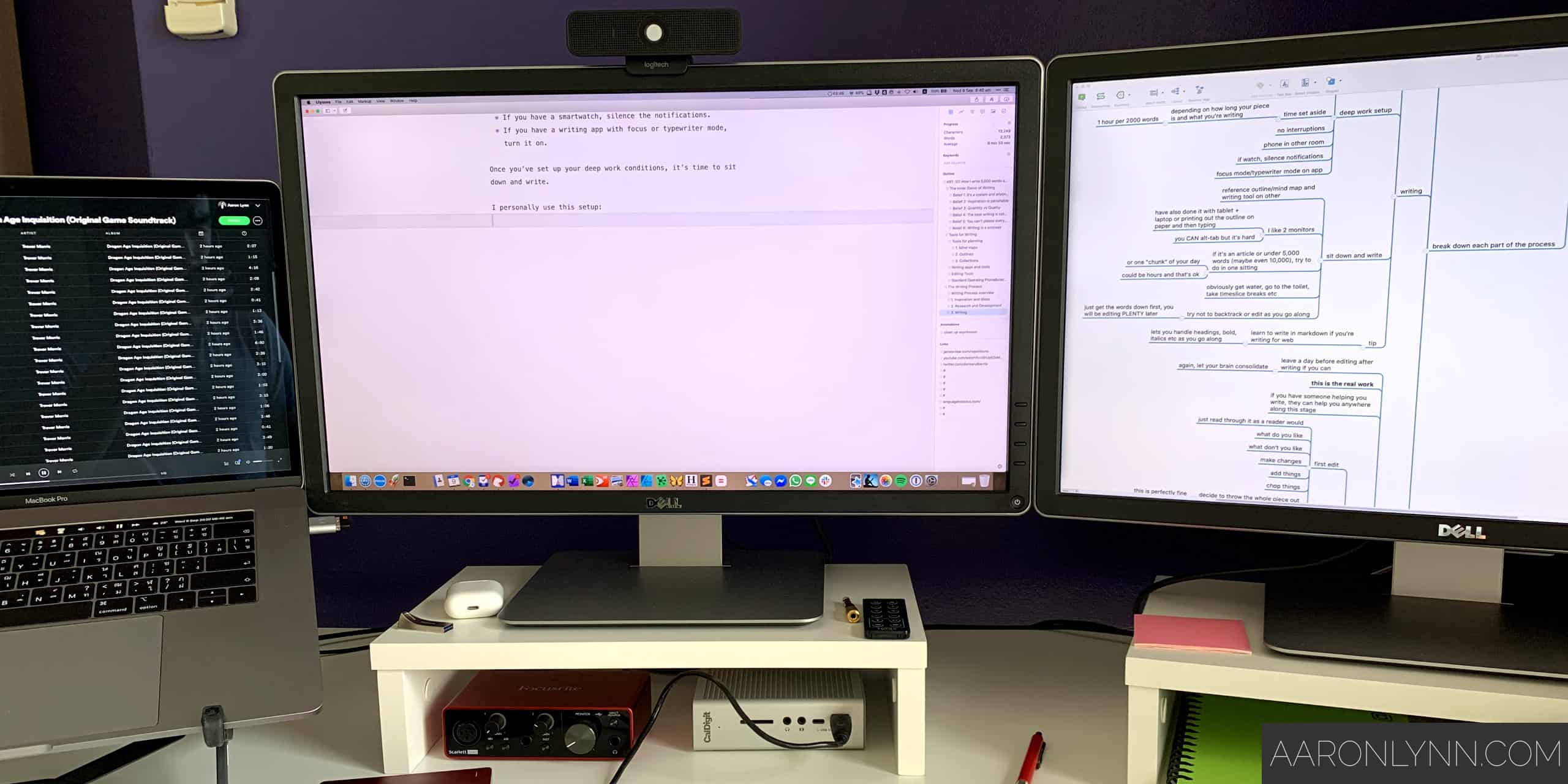
I have my plan/mind map open on one screen, and type on my centre screen.
When I’m not at my desk I’ll use my laptop and a tablet as a second screen.
It is possible to alt-tab between an outline and your writing app, but it’s difficult, and second monitors are surprisingly inexpensive nowadays.
If your piece is 5,000 words (or even 10,000 words) or less, I would try to complete it one sitting.
And by that I mean one continuous “chunk” of your day, taking the necessary breaks for water, to use the bathroom, timeslice breaks and so on.
It doesn’t matter if it takes you 3-4 hours to complete — wherever possible, it’s better to get it all down in one go to preserve continuity in tone and tempo.
A couple of extra tips:
- Try not to backtrack or edit as you write. Just get it all down first. You will have PLENTY of time for editing later.
- If you are really unsure about something, add an annotation/note within the text and come back to it during editing. For example, I never link in full URLs while writing.
- Learn to write in Markdown if you are writing for the web. This lets you add bold, italics, headings and more as you write, making your editing and publishing job much easier later on.
4. Editing
Ah editing. This is where the “real work” of writing happens.
Like writing and research, leave a day between when you finished writing and editing to let your brain consolidate what you have created.
If you have a research assistant, proofreader or someone helping you with your writing… this is the stage where they can help you, at any time.
Here are the specific sub-stages that I use for editing.
4.1 First edit
The first edit is simply you sitting down, and reading through the piece as a reader would.
Ask yourself:
- What do you like?
- What don’t you like?
And make changes as you go along.
Be liberal in adding things, cutting things and rearranging things.
Fix any stylistic, grammatical or expression issues as well.
If you get to the end and your gut feeling is that you don’t like what you’ve written — throw it out and move onto the next piece. There’s absolutely nothing wrong with that.
4.2 Tool edits
The second sub-stage of editing is to use the various stylistic tools available to you.
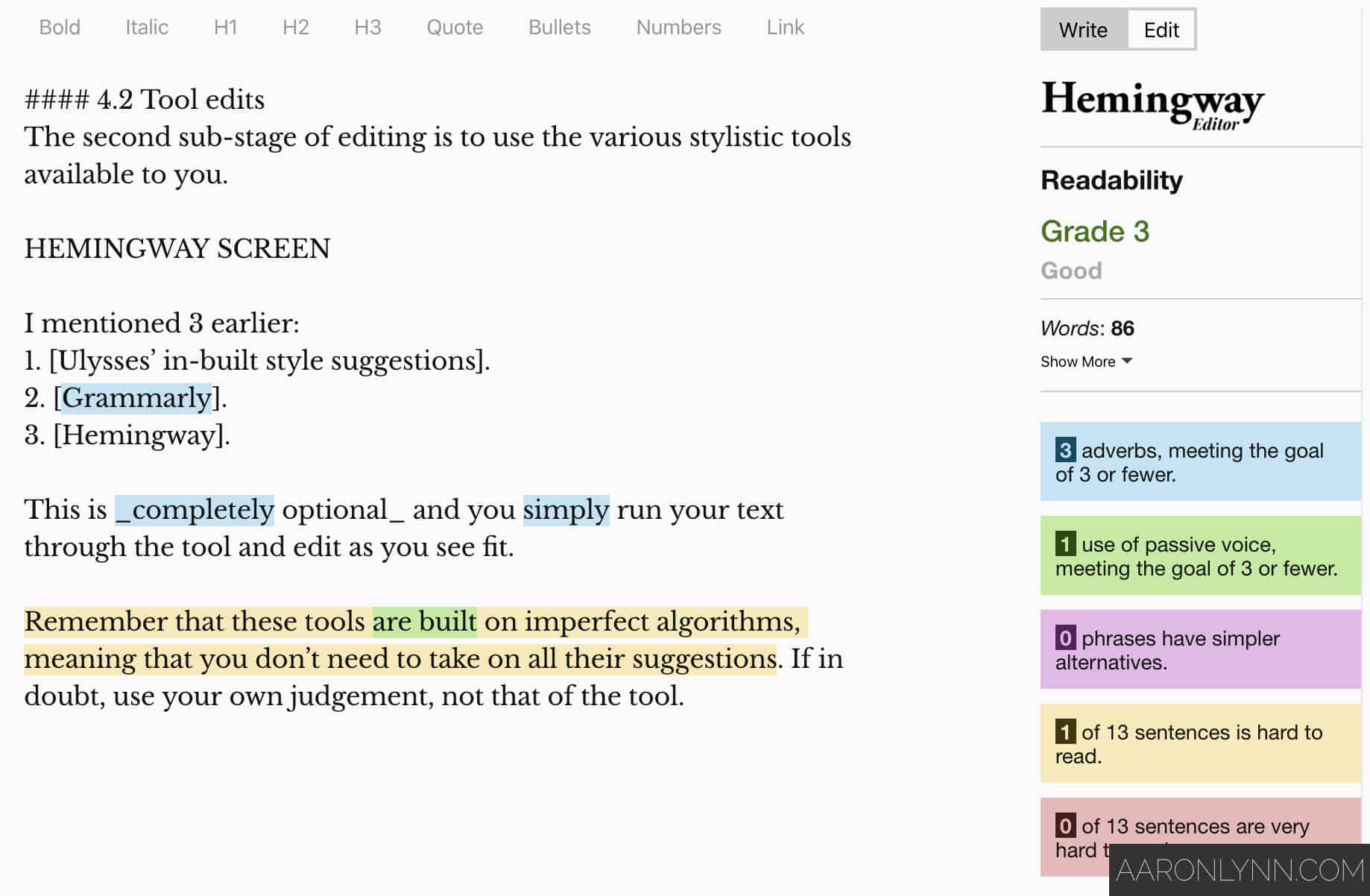
I mentioned 3 earlier:
This is completely optional and you simply run your text through the tool and edit as you see fit.
Remember that these tools are built on imperfect algorithms, meaning that you don’t need to take on all their suggestions. If in doubt, use your own judgement, not that of the tool.
4.3 Checklist edit
A checklist edit is exactly what it sounds like:
Using a checklist of sorts to edit your written piece.
This falls under the standard operating procedures that I recommended you create for your own writing process.
Depending on what you are writing for, this could be:
- Proper citation formats.
- Links.
- SEO considerations.
It could also be stylistic items, such as:
- Is your lede clear?
- Is it clear who the article is for?
- Is it simple to understand?
- Could people skim this on their phone on the subway?
- Does the writing deliver on its promise?
4.4 Edits to infinity
I like to do a second read-through of completed pieces after all the above steps.
This is very much like the first edit except your piece will be much more polished now.
At this point you can continue reading and editing pretty much forever until you are happy with the piece, and for longer pieces of writing, many rounds of editing may be necessary.
This is also a great time to have others help read over the piece for you.
At some point though you need to decide that it’s “good enough” and move onto the next stage in the writing process.
5. Graphics
If your writing needs graphics, diagrams or illustrations, this is the time to create them and insert them.
A tip I learnt from Mark Manson is to pick a general theme for your piece, gather lots of images related to that theme and then eliminate the ones you don’t want.
6. Proofreading
Proofreading is not the same as editing.
Whereas editing is about style and expression, proofreading is about grammar, typos and other errors.
The best way to proofread is to have someone else do it for you.
If you can’t do that, then you can do it yourself by reading your piece aloud, word-by-word.
By this point in the process, there should be no major changes.
By the end of proofreading, your writing is considered “done” and shareable with others — the rest is really just formatting and distribution.
7. Publication/Typesetting/Marketing
Technically, publication and marketing aren’t part of the writing process.
Whatever your plan is to package and distribute your writing, this is the stage for it.
Publishing could be uploading it to Medium, typesetting it as a book or posting it on your blog.
Marketing is simply what you will do to distribute and have others read what you have written.
How I Write
The system above can be taken, modified and used to produce any kind of writing that you want.
Everything that follows from here are idiosyncrasies that I’ve adopted to fit how I like to work and write.
You don’t need to adopt any of these to produce consistent, quality output on a daily basis, and I simply provide them as a reference point or inspiration for how you can implement your own writing system.
Write in batches
I mostly write essays, guides and articles for my website and these vary in length from 700-5,000+ words.
Because of this I like to work in batches of articles.
About once a month, I’ll sit down and look over the content ideas that I’ve captured and pick ten articles to start researching.
I have personally never understood the common concern of “running out of things to write about” because well… if you really understand and are passionate about a subject area, then you should be able to write about it pretty much forever.
This means that at any given time, I have at least 10 articles that are in the various stages of planning, writing, editing, proofreading or publication.
This is a form of batching tasks for efficiency.
If inspiration strikes however, I will often add an extra idea to my pipeline and just start working on it. This is the idea that inspiration is perishable and that you should use momentum to your advantage.
That’s how this guide came about actually — I was speaking with my friend Tom and mentioned that I had just finished a 5,000-word article that morning, and he said “I’d read a guide on how to do that”. And so, here it is!
Track using a Kanban board
Kanban boards are a project and workflow management technique originally developed by Toyota for car manufacturing.
In their modern form for knowledge work they look like this:
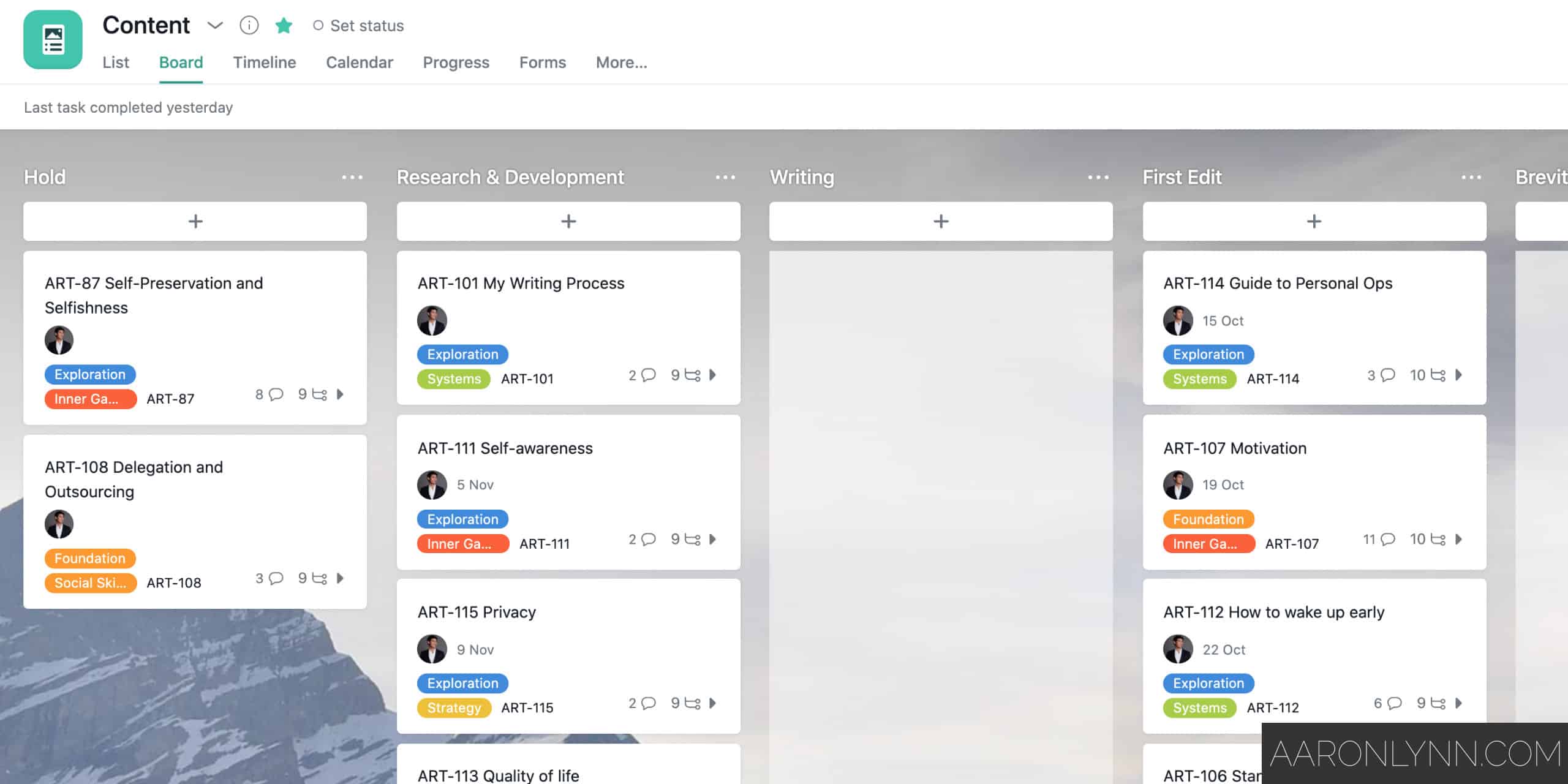
I use a Kanban board to track all of my writing.
As you can see, there are different articles at different stages at any given time.
The advantage of this is that I always know what is next for a given article: That editing comes after writing, that proofreading comes after editing and so on.
Each of these articles has a corresponding folder on my computer where I store the mind map, images and collected information.
Because I write primarily for my website, each article also has a category, an article type and even a unique identifier. The reason for this is that it’s much easier to say “tomorrow I’m going to write ART-101” than “tomorrow I’m going to write my article about writing”.
The screenshot above is from Asana which is what I use to manage all my work projects.
Each article task in Asana doesn’t have much in it. There may be an outline of the general article idea, and there are subtasks per each stage of the writing process.
There is also a due date which corresponds to the publication date.
Asana has a neat calendar view that lets me plan publication dates like this:
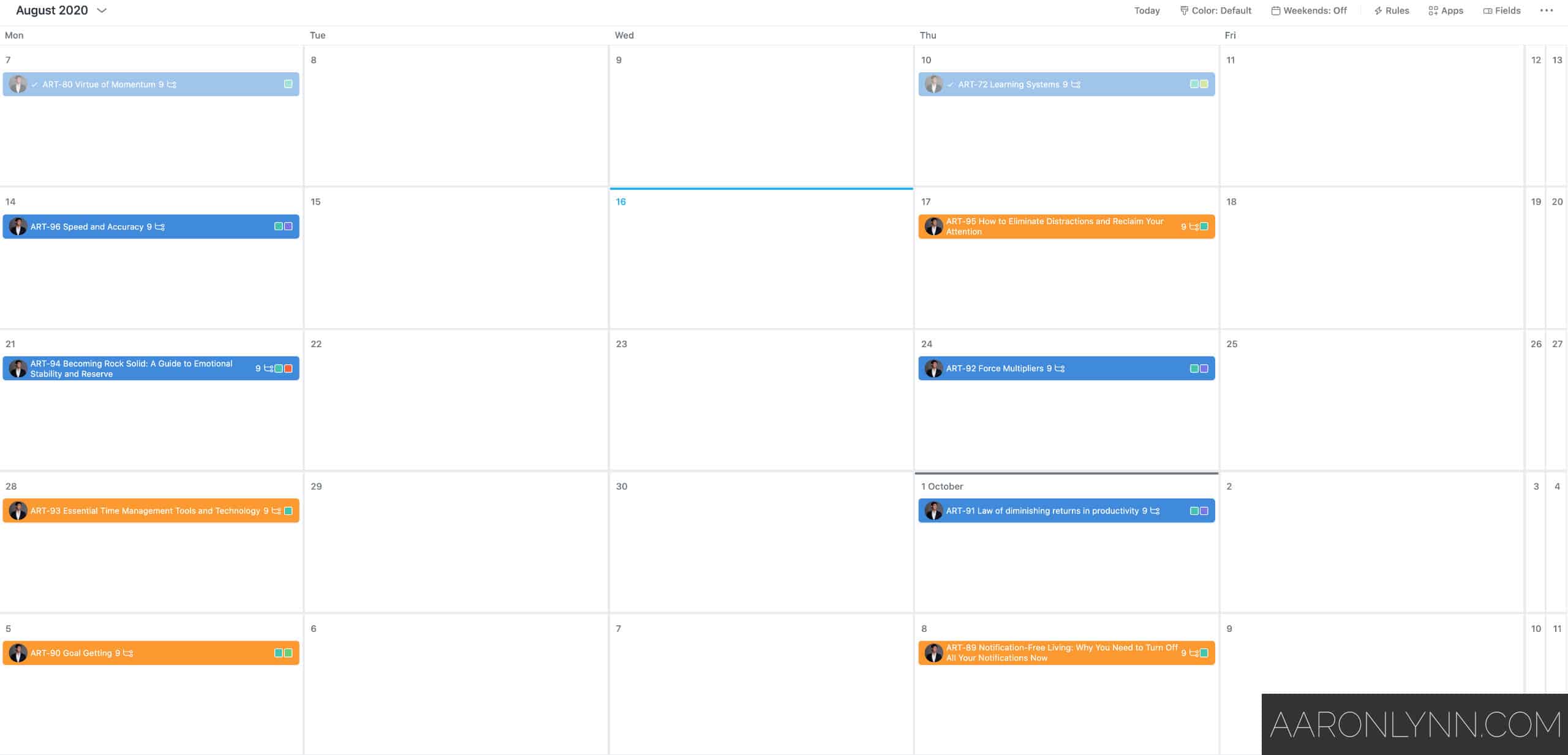
I have become quite efficient and effective with my writing which means that I am usually ahead on articles by 2-3 months.
In terms of management I literally just move articles through each stage of the writing process until they’re done.
Writing automation
I am a big fan of workflow automation and I use this to help me write more efficiently too.
In this case, I use Zapier alongside Asana so that when a writing task is added to my writing Kanban board:
- It automatically receives a unique identifying number.
- It has a folder created on my computer.
- A templated mind map outline is copied into that folder, ready for me to start putting ideas into.
Note: This is completely optional and NOT necessary to consistently produce quality writing.
Content as #1
There’s the old internet marketing maxim which is that “content is king”.
What marketers refer to is that a brand or company’s content is the most important thing in its long-term success and promotion online.
I have a different take on this idea.
As a writer, writing is the most important thing that I do.
Without fail, every single day I will work on something related to my writing.
It will not always be writing. Sometimes it is research. Sometimes it is editing. Sometimes it is publication and formatting.
But there will always be something every day, and I make it a point to make it my most important task of the day.
This means it is the first thing I do every day, usually when I sit down to start work at 6am.
With some deep focus and this writing system, I can write 5,000 words a day because my systems, structure and routines are set up for it.
(For reference, this article is at ~4,000 words and I’ve been at it for about 1.5 hours.)
What To Do Next
Writing doesn’t have to be difficult.
With a proper system, I believe that anyone can train themselves to consistently produce quality writing and output, every single day.
I’ve given you that system, in full, above.
Now it’s your turn to take it, modify it and use it for your own work.
- Hat tip Dr Clare Lynch of Dorris and Bertie.
Photos by Patrick Fore, Kelli Tungay.
